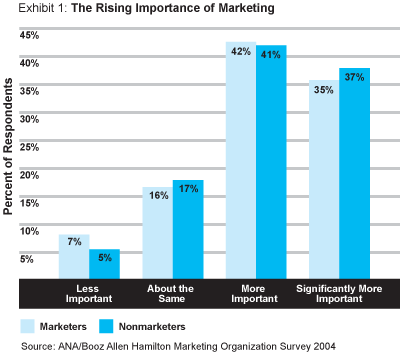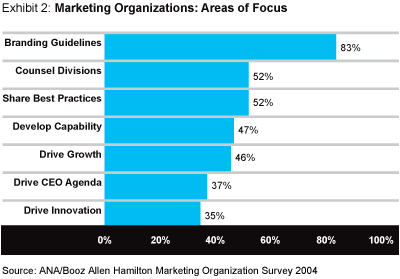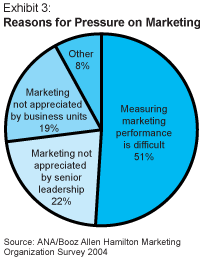Making the Perfect Marketer
A study from the Association of National Advertisers and Booz Allen Hamilton suggests five ways to make marketing more relevant than ever.
 |
|
Illustration by Bob Goldstrom |
His colleague, Don E. Schultz of Northwestern's Medill School of Journalism, is even more severe. "The marketing function is being pushed lower and lower in the corporate hierarchy," Professor Schultz wrote in 2003.
To investigate the truth behind these assertions, the Association of National Advertisers, the leading U.S. marketing trade organization, partnered with the global strategy and technology consulting firm Booz Allen Hamilton to discover whether marketing is in fact disconnected from companies' leadership agendas, to determine the causes of any dysfunction, and to uncover the best practices of superior marketing organizations.
After analyzing the results of an online survey of 370 marketing and nonmarketing executives at more than 100 companies in nine industries, which was supported by in-depth interviews with marketers across multiple industries, the research team arrived at a surprising conclusion: Contrary to the prevailing wisdom, the marketing function is more important now than ever before. But marketers, the men and women charged with running and operating the function in product and service industries, are having a hard time keeping up.
Specifically, the study -- the first part of an anticipated two-phase inquiry into structure, competencies, value, and accountability in contemporary marketing organizations -- identified three dichotomies hindering the effectiveness of marketing organizations:
-
More than 75 percent of marketers and nonmarketers say that marketing has become more important to their companies during the past five years. But at more than half of all companies, marketing and the CEO agenda are not aligned.
-
Higher expectations for marketing have driven nearly 70 percent of all companies to reorganize their marketing departments during the same period. But a major component of many such reorganizations, the position of chief marketing officer, remains ill-defined.
-
Measurable outcomes are now expected for marketing programs -- 66 percent of executives say true ROI analytics are marketing's greatest need. But most companies are still using surrogate metrics, such as awareness, instead of ROI measurements.
Fragmentation Follies
Today's marketing quandary stands in stark contrast to the 1950s and '60s, the era when the modern marketing organization was born, and when many of its current leaders grew up. For the most part, it was an "Ozzie and Harriet" world of intact nuclear families moving into new homes in expanding suburbs. Everybody read Life or the Saturday Evening Post, took an a.m. and p.m. newspaper, watched the Big Three television networks, gleefully greeted the latest fast-food restaurants, and washed clothes with the same brand-name detergents.
Around 1980, this cozy, centralized conformity began to shatter. The second oil embargo ushered in a severe recession -- and the recognition that economic growth had become punctuated and inconsistent. The birth of CNN heralded the rise of cable television and the continuing technologically induced fragmentation of media, markets, and consumer attention. The Iranian hostage crisis forced Americans -- and the rest of the world -- to confront globalization firsthand.
Today, all businesses are grappling with the problems posed by continual, discontinuous change. Globalization, the Internet, and rising information transparency have led to an increasingly mobile work force, fickle customers, and disruptive technologies and business models, which make firms less able to predict, let alone control, the near-term shape of their markets.
Few functional areas have been hit as hard as marketing. Across sectors, customers are able to demand and receive progressively more customized goods and services. Meeting such demands, in turn, has boosted companies' complexity and cost of doing business, and put pressure on marketers, in particular, to understand customer needs, seek real profits from each segment, and measure outcomes. In the face of growing customer choice and market transparency, the shift in marketing's emphases has been profound:
-
In the era of mass marketing, the primary source of value for most companies was their products or brands; today, value is moving to the customer interface.
-
Marketing's focus, formerly on advertising-based brand development, has shifted to "below the line" operations capable of driving short-term, measurable financial returns.
-
Companies' sales efforts, once characterized as "one size fits all," are transforming to meet customer demands for unique solutions and value-added services.
Marketers have been forced to evolve from a world where, as Henry Ford once put it, "You can have it in any color so long as it is black" to one in which customers routinely demand, "I want it in this color, in this configuration, at this price, and if you can't deliver tomorrow, I'll source it over the Web from any dealer who can within a 600-mile radius."
Marketing's Importance
These trends are widely perceived to have wreaked havoc on the marketing organization. As companies have met their growth challenges by consolidating and globalizing, power appears to have shifted away from marketing and toward more regimented (and readily understood) functions. "In financial institutions, marketing usually takes a back seat to hard and deep disciplines such as finance or operations," ABA Bank Marketing has noted. "It's not uncommon to find the head of marketing reporting to the CFO or COO."
But our survey found the conventional wisdom about marketing's decline to be inaccurate. Indeed, our first finding was that marketing is increasingly important to corporate success. Across all industries, nearly four out of five respondents said that marketing was becoming far more important to their organization. The responses ranged from the 86 percent of health-care industry respondents who said that marketing had become "more important" or "significantly more important" in their company during the past five years to the 59 percent of auto executives who said the same.
It is noteworthy that the results were essentially the same for marketers and those in other departments. Overall, 77 percent of marketers and 78 percent of nonmarketers said that marketing had become "more" or "significantly more" important. (See Exhibit 1.)

The majority of survey respondents cited the ferocity of competition in their industry as one of the top two factors underlying the growth in marketing's importance. Yet across the nine industries we studied, a surprisingly high percentage of correspondents believe the function's most important contributions lie in zones not typically associated with marketing, such as driving innovation and encouraging cross-functional collaboration. For example, 79 percent of the study's consumer packaged goods (CPG) respondents felt that "marketing is best positioned to orchestrate across corporate functions to create and promote new products and ideas." Executives in the retail, financial services, professional services, and technology industries also cited marketing's ability to help create new products and services as being among its highest-value contributions.
It used to be that a company could rise to the top of its industry and deliver superior shareholder returns by doing one thing well. Not anymore. Marketing's perceived ability to orchestrate multifunctional collaboration and its role in driving primary demand in markets that suffer from low rates of consumption indicate that marketing is becoming increasingly important in industries where it has traditionally taken a back seat.
In the financial-services sector, to cite a prominent example, marketing has taken on heightened importance as institutions conclude that their options to grow through acquisitions and product differentiation are diminishing. "The financial-services business is commoditizing; if you think this is still a relationship business, you are kidding yourself," an executive vice president at one such company told us. The chief marketing officer of a bank said his organization's work was ever more focused on helping the company "break down the silos across our distinct lines of businesses, ensure an integrated, consistent customer experience, and help drive innovation." Reflecting these comments, 33 percent of financial-services industry respondents cited the need for organic growth as a reason for marketing's increased importance.
Marketing's potential appears underscored by the organizational attention it is receiving. More than 70 percent of respondents to our survey indicated that the marketing function in their company is currently being reorganized, or has been reorganized during the last three years. Organizational restructuring was least likely in the CPG and health industries, but even in these sectors, nearly 60 percent of those surveyed indicated they had undergone a recent marketing reorganization. Restructuring was most likely at telecommunications and technology companies -- at nearly 85 percent -- where competition is raging and new product innovation is quickly matched in the marketplace.
As reorganizations mount, the position of chief marketing officer is gaining currency. Forty-seven percent of Fortune 1000 companies now have a CMO, according to our analysis. Among the companies that have created or reinstituted such a position in the past three years are Visa International, Equifax, MetLife, Revlon, General Electric, Symantec, JP Morgan Chase, The Bank of New York, The Home Depot, Charles Schwab, McDonald's, Cigna, and Pitney Bowes. The title remains less familiar than other positions in the "C suite." For example, 98 percent of Fortune 1000 firms have a chief executive officer, 91 percent have a chief financial officer, and 83 percent have another once-unfamiliar position, the chief human resources officer.
Marketing's Shortfalls
As the CMO position is becoming more common, so are its perils. Chief marketing officer is deemed to be among the most hazardous positions in the modern firm, with CMO tenure averaging only 23 months -- less than half the tenure of CEOs in 18 industries surveyed, according to CMO Tenure: Slowing Down the Revolving Door, a report issued by the executive recruiting firm Spencer Stuart in August 2004. The food industry has the shortest average CMO tenure of any sector studied, a mere 12 months.
The failure of so many CMOs in the face of such high expectations and persistent reorganizations indicates a serious disparity between companies' needs and marketing's proffered solutions. In a more and more complex and rapidly changing environment, the function seems caught in a vicious cycle: new CMO, reorganization, failed expectations, new CMO … and so on.
To investigate the reasons for the apparent mismatch, we sought to calibrate marketers' own evaluation of their emphases and contributions against those of company leaders. According to the Conference Board's comprehensive annual survey CEO Challenge 2004: Top Ten Challenges, the top four chief executive priorities are:
-
Top-line growth (52 percent)
-
Speed, flexibility, adaptability to change (42 percent)
-
Customer loyalty and retention (41 percent)
-
Stimulating innovation (31 percent)
Marketers appear to be giving at least some of these priorities short shrift. By a wide margin, marketing's focus is heavily tactical, and disconnected from the CEO agenda. Fully 83 percent of respondents, for example, said marketing's current focus in their company is branding guidelines -- more than two-and-a-half times the number who said they were focused on driving innovation. (See Exhibit 2.)

In fact, fewer than half of respondents indicated that the issues that keep CEOs awake at night are at the top of marketing's agenda. This disconnect is causing immense frustration over the role and performance of marketing.
 Perhaps the major reason marketing is not appreciated by senior leadership is its inability to justify its return on investment. Although everybody talks about "marketing ROI," limited progress seems to have been made on revamping marketing metrics. "There is no consistent definition of ROI," said the vice president of finance at a CPG company. "We are using 'rule of thumb' guidelines." (See Exhibit 3.)
Perhaps the major reason marketing is not appreciated by senior leadership is its inability to justify its return on investment. Although everybody talks about "marketing ROI," limited progress seems to have been made on revamping marketing metrics. "There is no consistent definition of ROI," said the vice president of finance at a CPG company. "We are using 'rule of thumb' guidelines." (See Exhibit 3.)
We found that marketing organizations are still predominantly using "surrogate metrics" instead of more disciplined financial-returns measures to assess the value of their contribution to the enterprise. Marketing ROI is more complex than financial ROI, where both the "R" and the "I" are uniformly measured in dollars. In marketing, various quantitative factors (e.g., cost per incremental volume) and qualitative factors (e.g., awareness) are part of the equation -- over both the long and the short term. High-touch, relationship-based industries with differentiated products (such as financial services and automotive businesses) tend to use awareness- and image-related forms of measurement. Low-touch industries (food and retail), in which marketing creates differentiation among commodity products, rely more on market share, growth, and profit metrics.
Although these forms of measurement may be valid to the tasks at hand, we surmise they have not been adequately explained and "sold in" to other senior executives, who typically come from backgrounds with different rigors. Among marketers themselves, there is a lingering, if fading, fear that too much "science" might dampen the "art" of marketing. Some marketing chiefs value unbridled creativity and innovation over multivariate regression models that isolate the incremental consumption delivered by a new program or ad execution. Although this communication gap involving metrics is understandable, given the novelty of the CMO position relative to other officer positions, it appears to be contributing to the diminished status of CMOs in many companies.
The Successful CMO
In general, corporate responses to the question of marketing's relevance have fallen short of what is required. By focusing largely on reorganization and upheaval rather than upgrading metrics and building new capabilities to meet the CEO's expectations, companies are consigning themselves to renewing disappointment. In our in-depth interviews with marketers, however, we explored some of the emerging best practices that successful marketing organizations are employing to align themselves with the CEO agenda. We've distilled these lessons into five success factors for actual -- and prospective -- CMOs.
1. In conjunction with senior leadership, consciously choose from among the three emerging CMO models the one best suited to the company and its current needs. Our interviews indicate that three distinct models are developing out of the chaos of the CMO position's early years: Marketing Service Provider, Marketing Advisor, and Driver of Growth. These coincide roughly with the three models found by Harvard professors Gail McGovern and John A. Quelch. (See "The Fall and Rise of the CMO," s+b, Winter 2004.) Although our three models overlap, each reflects different CEO expectations, and thus different capabilities of the CMO and his or her team, on a scale that slides up from the purely tactical to the heavily strategic.
Marketing Service Providers, for example, lead a small corporate staff function; manage marketing services that offer centralization benefits, such as media buying; and coordinate marketing-service supplier relationships. Marketing Advisors tend to lead a corporate marketing function, help align division marketing plans with corporate strategies, ensure compliance with corporate trademark and brand guidelines, and coordinate the sharing of best practices across the businesses.
Drivers of Growth, by contrast, partner with the CEO in propelling the corporate growth agenda; direct brand strategy, business development, and innovation; drive the marketing capability agenda and ROI; and are empowered by the CEO to align marketing in the business units, and their personnel, with the central agenda.
2. Agree from the beginning on a "marketing contract" with the CEO, and continually check progress against it. If marketing metrics differ from organization to organization, if the CMO role varies from one company to another, it stands to reason that a new chief marketing officer may have an indistinct understanding of his or her goals and authority. A leadership contract is an effective tool for establishing the decision rights needed to lead an effective organization. The key elements of the contract are:
Agenda. Whether the objectives are prosecuting the CEO's growth strategy or raising brand awareness, marketers and the chief executive must be unified. As one senior marketer told us, "Don't even think of having a CMO without the support of the CEO."
Controls. "Marketing may not have full control over all of the 'Ps,' but it should have a strong say," a top automotive marketer said. If marketing is charged with developing and executing a strategy aimed at realizing benefits from premium pricing, for example, it ought to have some authority in making pricing decisions.
Outcomes. When considering revenue, earnings, market share, degree of conversion, ROI, or something else, marketers and their leadership must agree on how they will measure success. "Most CMOs run into trouble because expectations are not clearly set and CEOs run out of patience," said a top marketer at a financial-services company.
Visibility. In companies or industries where marketing does not have a track record, it is important to figure out "how to market marketing," as one senior vice president at a financial-services firm told us. In industries like consumer packaged goods, where marketing rules the roost, marketers may face a different but equally difficult challenge to their relevance. "Everybody thinks they are a marketer, and therefore they value the marketing function less," a vice president of marketing at a CPG company pointed out. In either case, it's vital that the CEO be a visible supporter of the marketing agenda within the organization.
3. Develop organizational linkages. The CMO's role is a mix of control and influence. Clear guidelines about how to market with -- not through -- other demand-side functions, such as sales, R&D, and the corporate or business unit marketing departments, are essential to success. At one company, a blend of formal and informal linkage mechanisms includes weekly videoconferences among key stakeholders in any decision. "It's critical to be clear about what you own, what is matrixed, and what you need to informally influence," said the chief of U.S. marketing for a global corporation.
One pitfall for CMOs is letting the pressure of the "urgent" at the business unit level drive out the "important" at the corporate level. "Business-related marketing issues should be the business units' call, but if it has to do with people and capabilities, the CMO decides," the CMO of an industrial products company told us.
4. Drive a marketing capability agenda. One of the major findings of our study is that CEOs are asking much more of marketing, particularly in the area of capability development. Moving the organization ever closer to true ROI marketing capabilities -- an approach that blends data gathering and evaluation, decision rights, implementation, and outcome-based organizational adaptability, all toward the goal of more profitable sales -- will provide marketers with credibility, support, and increased leverage.
5. Take risks -- come up with the big ideas. Yes, establishing decision rights is essential and building ROI capabilities is critical. But sometimes you've got to stick your neck out. Several of our study participants say marketing needs to get more comfortable in taking risks. They see their role not simply as supporting but as coming up with the big ideas that can really make a fundamental impact on the fortunes of the company. "Marketing needs to figure out how to balance the big, innovative ideas with the sustaining ideas," said a CPG company's senior vice president of marketing.
Marketing, it's clear, cannot concern itself simply with brand identity guidelines, good television commercials, and rising awareness scores. "Marketing is about building new businesses, finding the white space, and leading the integration across the organization with sales and R&D," said the senior vice president of marketing at a global food company. In the end, nothing will collectively build the credibility and legitimacy of a CMO more than standing on the front line, leading the charge in support of the CEO's agenda.![]()
|
About the Marketing Organization Study |
|
In 2004, the Association of National Advertisers (ANA) and Booz Allen Hamilton launched a study to determine the relevance of marketing, marketing departments, and chief marketing officers (whether they operate under that title or another) in today's business climate. The first phase of the ANA/Booz Allen Hamilton Study of Marketing Organizations was conducted from June to September 2004. Three hundred seventy respondents from more than 100 companies in nine industries completed a confidential survey of 20 questions. Nearly half of the respondents -- 45 percent -- hold corporate marketing positions, and 39 percent are in divisional marketing roles. The remaining 16 percent of respondents represent a wide variety of staff and line positions. The survey findings were supplemented and supported by in-depth interviews across multiple companies and industries. The industries represented were auto, consumer packaged goods, financial services, health, manufacturing, professional services, retail, technology, and telecommunications. |
Reprint No. 04405
Paul Hyde (hyde_paul@bah.com) is a vice president with Booz Allen Hamilton in New York. Specializing in organization and change leadership, he works with a broad range of clients to improve effectiveness through increased customer focus.
Edward Landry (landry_edward@bah.com) is a vice president with Booz Allen Hamilton in New York. He focuses on strategy and sales and marketing effectiveness for consumer packaged-goods and health-care companies.
Andrew Tipping (tipping_andrew@bah.com) is a vice president with Booz Allen Hamilton in Chicago. He specializes in the organization and change leadership aspects of customer-focused transformation for companies.


